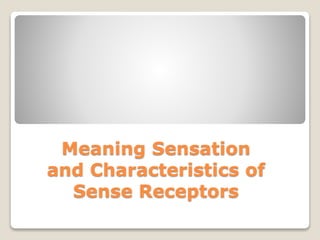
Sensation and Characteristics of Sense Receptors
- 1. Meaning Sensation and Characteristics of Sense Receptors
- 2. SENSATION- Is the simple experience that arises from the stimulation of the sense organs. It is the process of accepting the stimulus by the sense. The giving of the interpretation or meaning to the stimulus by the brain to respond appropriately is referred to as perception. STIMULUS- is any form of energy that can cause awareness or change to the consciousness (light waves, sound waves, temperature, chemical state- liquid, solid, gaseous, etc.). This stimuli are then modified and accepted by the accessory structures (eyes, ears, nose, tongue, skin, etc.). from the accessory structures, transduction occurs at the receptors.
- 3. RECEPTORS- this are specialized cells responsible for detecting of energy as a result of transduction. TRANSDUCTION- is the process of changing the stimulus sense into energy for neural activity. PSYCHOPHYSICS- Is the relationship bet. The physical and psychological environment.It connects the external and the internal world of an individual this aims to examine the sensitivity of an individual to various stimuli. Then it determines the psychological perception of the stimulus. The process assess the presence and intensity of the stimulus.
- 4. ABSOLUTE THRESHOLD - This is the least quality and quantity of a stimulus that can be sensed and perceived consequently. DIFFERENCE THRESHOLD - This is the minimum difference in intensity between two small stimuli when caused by a smallest change. It does not only determine the presence or absence of stimulus but also detect whether the two small tstimuli different or the same.
- 5. ACQUIRING SENSORY AWARENESS/ THE SENSORY SYSTEM
- 6. ACQUIRING SENSORY AWARENESS The stimulation of a receptor is the first essential condition to have a sensory experience. This means that a stimulus is applied to a receptor organ. The stimulus that comes from the environment may be in the form of physical energy like heat, light, sound, and pressure; it may be in chemical form like a substance that you can smell or taste. The energy must be strong enough to produce a response. The receptors in our body are commonly called sense organs. They are the doorways of our body.
- 7. RECEPTOR ORGAN- receptor organs are highly specialized part of the body and is selectively sensitive to a definite stimulus. The second condition is the presence of a receptor cells in the process of sensation, receptor cells in the sense organ detect stimuli from the environment and transmit information to the appropriate areas of the brain. The third essential condition that you need to experience a sensation is that the stimulus must be transformed into a code of electrochemical impulse which travels to the brain. This stimulus must be transduce, that is, the physical energy is converted into activity in the nervous system. The specialized cells transform the physical energy into electrical voltage, this voltage are called receptor and generator potential. This works on the receptor cells to produce nerve impulses which travel to the brain and the sensation is produce.
- 8. When is stimulus detected? The stimulus is to be detected must be strong enough and to produce sensation, it should be at least in the absolute threshold. This threshold is in the lower limit of sensitivity. There will be no sensation of the stimulus does not reach or go beyond the threshold. When there is no sense awareness and that they escape unnoticed, the stimuli are said to be subliminal threshold. When they reach an increased intensity, they produce pain in the individual being stimulated and make him uncomfortable. When the stimulus at this point produces pain, which is not a normal response, the stimulus is said to be in the terminal threshold.
- 9. When does a change in stimulation become noticeable? The sense organ possesses a certain sensitivity that enables it to notice changes in stimulation. The smallest amount of stimulus that can be detected is called differential threshold this is also known as discriminationthreshold or the just noticeable difference (JND). This is not constant over the range of stimulus intensity. The value of the differential threshold depends upon the overall intensity of the stimulus to which more energy is added. The JND varies widely depending upon the nature of the stimulus and the state of organism. There are times when one is prepared to see a difference, but there is nothing to be noticed because there is no differential threshold that can be reached in the change.
- 10. SENSORY ADAPTATION - is any reduction in sensitivity to stimulus as stimulation persists through time. Sense organ has the capacity to adapt to stimulus when such stimulus persists for a quite a time. It is the ability to adjust to a particular stimulus. THE SENSE ORGANS This are the different sense organs situated at different places in our body. Some receptors, called distal senses, are sensitive to stimuli coming from a distance in the outside environment. The proximal senses bring information only when we come in direct contact with the object that stimulates them.
